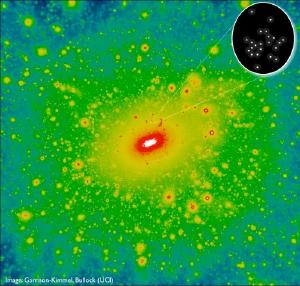Post
Bound
26 September 2013
Yesterday I talked about just how small a star can be, so today let’s explore just how small a galaxy can be. Our Milky Way galaxy is about 100,000 light years across, and contains about 200 billion stars. The largest known galaxy (IC 1101) is about 6 million light years across, and has a mass of about 100 trillion solar masses. The smallest galaxy? It has about a thousand stars.
This very faint galaxy is known as Segue 2, and can be seen in the inset of the image below. With only a thousand stars, and a diameter of about 150 light years, you might wonder how it can be considered a galaxy. After all, there are globular clusters surrounding our galaxy that have far more than 1,000 stars.
One of the conditions a galaxy must meet is that it must be gravitationally bound. That means the stars must be unable to escape from the gravity of the galaxy. For a mere thousand stars to be gravitationally bound, they would need to have extremely slow motion (no more than about 1 km/s). These stars have speeds about 200 times greater than that limit, and yet they are gravitationally bound.
 Garrison-Kimmel, Bullock (UCI)
Garrison-Kimmel, Bullock (UCI)What makes that possible is dark matter. Although Segue 2 only contains about 1,000 stars, its total mass is about 600,000 solar masses. This means that the vast majority of the cluster’s mass is dark matter. In fact, so much of Segue 2 is dark matter that it is basically a clump of dark matter with a few old stars trapped in it. Still, Segue 2 is a gravitationally bound cluster of stars with a dark matter halo. Thus, it is a galaxy.
What’s interesting about the Segue 2 galaxy is that it’s exactly the type of tiny galaxy predicted by dark matter. Not only does dark matter clumping provide the mechanism necessary to form such a small galaxy, but dark matter actually predicts that a small galaxy such as Segue should be mostly dark matter. That’s because the smaller your galaxy, the less material is available for star production, and the more dark matter plays a role in keeping the galaxy gravitationally bound.
Just as the smallest stars help us define what it means to be a star, the smallest galaxies help us define what it means to be a galaxy. What we are finding is that dark matter plays a crucial role in galaxies, particularly the little ones.